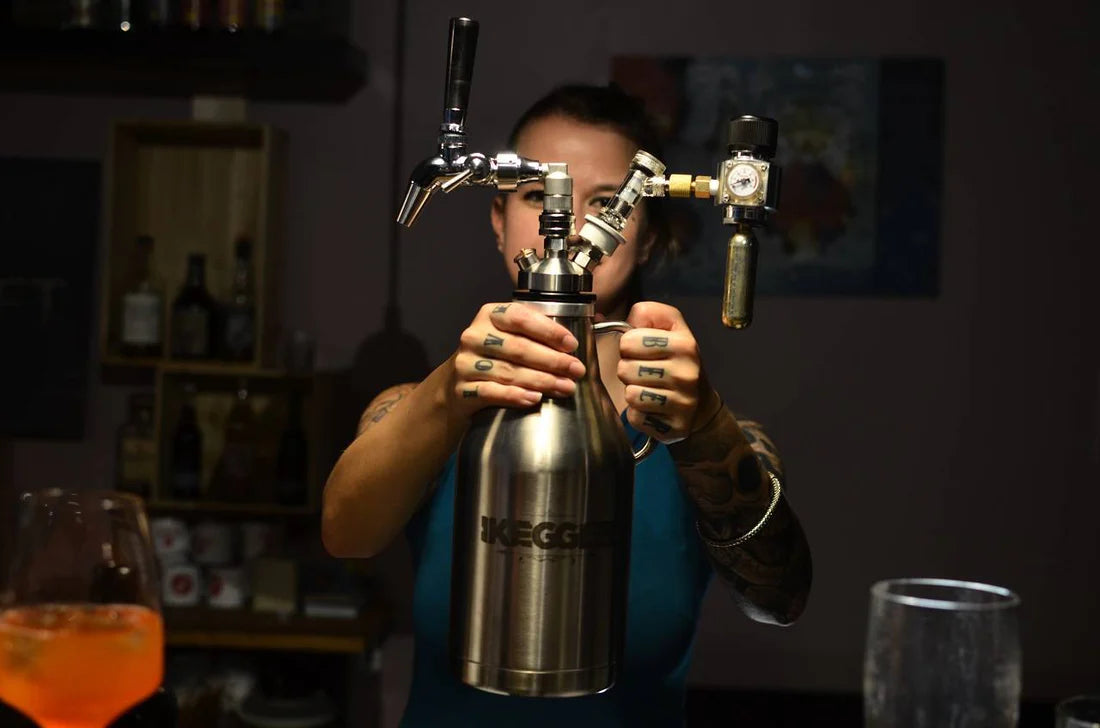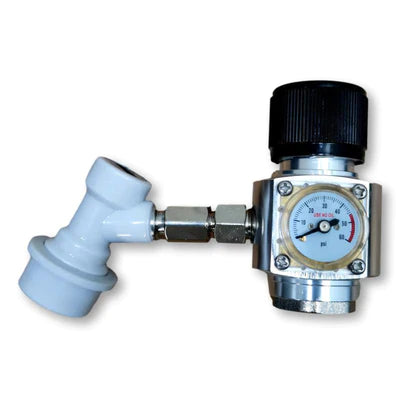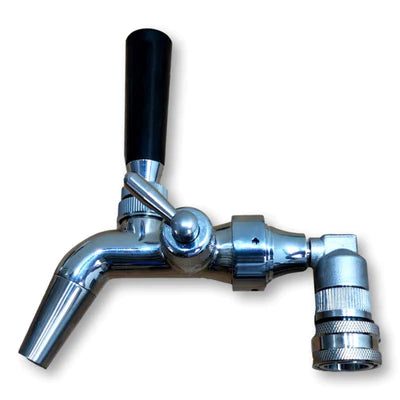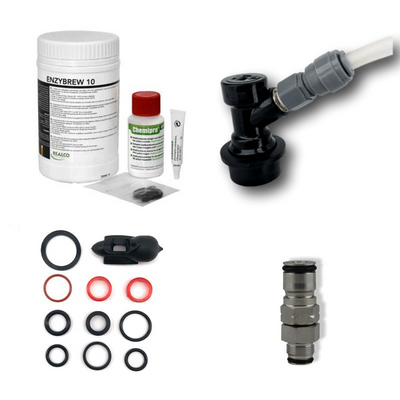Free & Fast Shipping Options In EU
Free & Fast Shipping Options In EU
About
Kegging Gear

The Ultimate 2024 Beer Growler Guide - plus iKegger vs uKeg
January 18, 2024 14 min read
So are beer growlers, a recent trend or a staple of history that's here to stay?
Would you believe that growlers have been around a lot longer than you think?
Despite what you might think, appreciating beer isn’t just about what’s inside the glass, you also have to consider the best way of serving and storing your beer. With today’s rapidly expanding craft beer market, the beer growler is considered by many to be an environmentally conscious option for having and keeping beer fresh. Others however, consider growlers to be a trend that will disappear as quickly as it appeared, but if something has already been around for hundreds of years, they probably aren’t going to “just disappear”.
So how long have growlers been around then?
As mentioned above, the quick answer is a long while! But before we can accurately answer that question, there’s a couple of other questions we should think about, including; what is a growler? Where did they come from? How have they changed over time? And what’s different about modern versions?
Once we’ve got some answers, we can look at the pros and cons of various types, some advice of what kind of growler would best suit your needs; from a $2 PET plastic bottle all the way up to stainless steel, insulated growlers that exist today. With technological advancement growlers today can store, dispense and carbonate, all while keeping it cool, fresh all day. If you’re a homebrewer, a beer enthusiast, someone who is interested in a bit of history or just looking for the best way to move your drink from point A to point B, this article has you covered.
GROWLER 101: THE STEINZEUGKRUG
As with many advancements in the beer world we have Germany to thank, so let's head back in time to when stone jugs were the height of technology.
The word "Steinzeugkrug" refers to a type of stoneware jug or stein that was common in Germany and traditionally used for serving and storing beer. These jugs were such an important part of German beer culture and have their own whole history spanning centuries, and can still be found in use today! Throughout history stoneware jugs have been used for storing liquid, including beer, for a very long time, predating even the middle ages. However, the specific version that we recognise today as the Steinzeugkrug rose to popularity and prominence during the 14th century, earlier versions were closer to just large stone cups and mugs and are unrecognizable from the highly decorated steins that you’re probably thinking of.

Material and Craftsmanship
The most common material used for a Stein is a specific type of ceramic known as stoneware. Stoneware is a dense, hard and non-porous material, making it perfect for storing liquids without affecting the taste. Another benefit of using stoneware was that molds could be made for mass production, which then quickly led to them becoming collector items as many would be embellished with unbelievably intricate carvings, relief work or painted designs.
These differences in design could be seen throughout the different regions of Germany. The Steinzeukrugs from Westerwald were known for their blue and grey salt-glazed jugs, while those from the Rhineand often had intricate brown designs. The regional differences didn’t just stop with how they were decorated, but the shapes and handles would often differ from region to region.
The Next Advancement Brings the Lid!
The addition of a lid to the stein was seen as a way to protect the beer from insects and dust, with many being made from pewter or silver. This change came about as Germany passed laws in the early 1500s that required food and beverages to be served in closed containers to protect consumers. It can also be argued that after the black plague wrecked havoc across Europe that many places were now more concerned with hygiene which the lidded steins also helped address.
THE FIRST BEER GROWLERS:
The word “growler” first popped up in America in the 18th century. It was used to describe any container that could be used to move beer from a brewery to your home. At the time the most common container was a 2-quart (1.8L or 64oz) galvanized or enameled bucket, which is still the same size as standard glass growlers today.

Why is it called a growler?
The most common story for how the growler got its name was that the sound of the beer sloshing around in the buckets combined with the sound of the co2 releasing sounded like a growl. So the “growler” was born.
The modern growler era:
As you can see growlers have gone through all sorts of changes, from stone jugs to metal buckets to now having evolved into the technologically advanced containers we have now, with features to keep your beverage fresh, cold and carbonated all day long.
These modern changes to the design have addressed the problems that the previous versions of growlers have had. We’ll now look at some of the problems that still exist and how to combat them in this modern era of growler designs, as well the differences between, glass, plastic and stainless steel versions.

FILLING BEER GROWLERS: THE PROBLEMS
Beer growlers of any sort are often filled straight from the beer tap. A cap of some sort was put on and away you went. If you know anything about beer you probably already know what problems can arise from being filled like this.
The main problem with filling any container directly from the tap is that you start introducing oxygen into the beer. Oxygen and beer do not get along, for long term storage, and your beer will start tasting like wet cardboard after a while through a process called oxidation. Of course due to the fact that you’re not filling the growler in a closed circuit, you also run the risk of adding bacteria which can spoil your beer.
Another issue is the pressure and carbonation of the beer, while filling like this the pressure does not remain constant and is different to the level that it was stored at in the keg. Too much pressure and the beer will become over carbonated and on the other end of the spectrum, too low pressure results in an under carbonated beer.
Leading from this, because there’s no pressure in the vessel, there’s no carbon dioxide in the headspace of the container (the gap above the liquid), you’re more likely to end up with under carbonated beer. As once the lid is in place, the carbon dioxide will escape the beer to fill the space leading to flat beer after a period of time. Especially if you’re constantly opening and closing the container.

There are of course ways to combat all of this, one invention is the “counter pressure growler filler” made by companies like Pegus. These create a closed filling circuit, purging the growler with co2, maintaining the pressure while filling to help counteract flat beer and removing the initial contact with oxygen. Taking steps like this creates a product very similar to commercially packaged bottle beer and can be stored for longer without any problems, until you open it, as you’ll still have the same problems with pressure loss, oxidation and the risk of introducing bacteria.
However machines like this are expensive to install and maintain, and can only have a certain amount of beer lines connected to them, so you’re probably unlikely to find too many of them out in the wild at your local breweries or tap rooms.
So how do we prevent these issues more cost effectively?
Top of the line growlers that come with taps and gas regulators can be filled with ease, while keeping the pressure and removing the worries about oxygen contamination, at any brewery or bar by following these steps:
- Use the regulator to purge the growler with gas
- The brewery/tap room/bar can then fill the growler using a hose directly from the tap (into the "cushion" of co2 to avoid oxygen contact)
- Quickly screw the lid on, inject some more gas and pull the pressure release valve to flush out any trace oxygen that might have got in.
- With the regulator you can then set the pressure to match the keg
- Now when you pour from the tap, more co2 will automatically go into the growler to maintain the pressure.
Any other problems?
There’s two more problems that can affect growlers, but these problems mainly relate to glass and PET plastic growlers.
So there’s a reason that most commercially available beer is stored in brown glass bottles, and that's because brown glass cancels out 90% of UV rays (as opposed to green and blue which only cancel out 20% and clear bottles cancel out well, none). This is important as UV light damages beer which causes beer to have a skunky taste. So you can see why the best of the best growlers are made from stainless steel, as UV light cannot penetrate through.
The second reason that stainless steel growlers are considered the best option over glass and plastic versions is that the stainless steel options can stay cooler for longer. Much like glass and plastic letting the UV rays in, they also heat up much quicker, which of course not only ruins the taste of the beer, but really there’s nothing worse than taking a sip of hot beer, especially when you’re expecting something cold and refreshing.
TYPES OF GROWLERS: A DIVERSE RANGE OF BEER STORAGE OPTIONS
Okay so we know the problems that need to be solved, and how to solve them. But what about the other pros and cons of each type of growler?
PET PLASTIC GROWLERS:

These are exactly what they sound like, large plastic bottles. In some instances any plastic bottle will work as long as it’s got a lid.
Pros:
- These growlers are lightweight, making them great for quick trips
- Plastic bottles tend to be the cheapest option, especially if you’re just reusing a soda bottle
Cons:
- The least environmentally friendly version of a growler, especially if not recycled properly
- If you’re reusing a plastic bottle you run the risk of the original contents leeching flavours into the beer
- Depending on the colour of the bottle you could be ruining it very quickly with UV light
- Heats up quicker
- Harder to keep pressure changes and oxygen contamination at bay
GLASS BEER GROWLERS:

The glass growler is the standard go to when most people think about growlers. The stereotypical growler is a 1.9L (64oz) brown glass bottle, usually with a handle on one side and a twist top lid.
Pros:
- Glass growlers are usually pretty affordable, and loads of breweries often sell them with the intention that you’ll bring them back to swap for a new full growler at a later date.
Cons:
- Again with the plastic bottles depending on the colour it may let a lot more UV light in leading to it spoiling faster
- Oxygen exposure is still an issue with glass growlers, unless of course they have a built in machine like the Pegas counter pressure filler but as we know that only helps with the initial oxygen exposure.
- Glass growlers are the most fragile out of all the options
- Just like the PET plastic bottles the glass growlers aren’t always the best for pressure and temperature too.
CERAMIC GROWLERS:

Remember at the beginning when we were learning about ceramic and stoneware jugs? Guess what, they still exist and are collected and used by many.
Pros:
- If you’re here for aesthetic reasons ceramic growlers definitely check that box
- The opaque walls prevent any UV exposure
- Stoneware and ceramic are pretty good at insulating and will stay cooler longer than a glass or plastic version
Cons:
- They’re expensive, but beauty is expensive right?
- Ceramic growlers are the heaviest already when empty, so imagine how heavy they’d be once full
- Although stronger than glass, they can still break pretty easily
VACUUM-INSULATED STAINLESS-STEEL GROWLERS:
The vacuum-insulated stainless steel growlers are the top of the line, go-to version of the stainless steel growler. A vacuum-insulated growler has two walls of stainless steel with a vacuum between creating the best insulation possible, keeping your beer cold all day.
Pros:
- Temperature is the biggest one right off the bat, a stainless steel growler can keep your beer cold for 24 hours
- Durability, it’s made from stainless steel, how easy do you think it’ll break? They’ll also last a very long time
- Solid walls means those pesky UV rays can’t penetrate and spoil the beer
Cons:
- They are more expensive than glass or plastic, but they’re built to last
-
Although they seal very well and can be filled under pressure, just like all the others once you open it the pressure will change and oxygen will get in
CO2-PRESSURISED TAP SYSTEM:
So a common problem with all the various different growler options is that by themselves, no single one solves the pressure and oxygen problems. But that’s okay as a few companies have filled the market with solutions on how to keep your beer as fresh as can be, as if it had come directly from your favourite brewery with every pour.
These systems usually run off of small disposable co2 bulbs, or soda stream bottles, which use gas to push the beer through the growler and out of a tap, which would mean you don’t need to open it until it’s empty, stopping any spoilage due to oxidation. This also means that the pressure stays the same as it was when filled, leaving you with fresh, perfectly carbonated beer every pour.
IKEGGER 2.0 VS UKEG COMPARISON

The two main competitors at this level are our iKegger growlers and the uKeg growlers. Now look, you’re on our website so of course we know what we think is the better product, but let's take a look at the two and see how they compare side by side.
Both the iKegger and uKeg systems feature:
-
Double-walled vacuum insulated stainless-steel body
-
A tap system to dispense your beer (or other drinks)
-
A device to push CO2 (or other gas) into the growler at a set pressure.
SO WHERE DO THEY DIFFER?
Looks and Aesthetic:
iKegger: Has a sleek, minimalist and modern design, with our 2.0 system boasting a patented push button tap. The regulator and gas bulbs are external making them visible for ease of readability and use, and gives it a more “techy” vibe.
uKeg: Has a more “vintage” or “steampunk” look, with brass pipes and a sight glass to see how full (or empty) it is with an attached gauge showing the internal pressure and tap. The regulator and gas bulbs are hidden inside for a neater look.
Horizontal Pouring & Storing:
iKegger: Our iKegger systems are the exact opposite of that! Not only can they be stored, transported and used horizontally, our 2.0 tap swivels for ease of pouring when laying on its side! The regulator even comes with a one-way valve which prevents any liquid going back into the regulator when lying horizontally.
uKeg: The uKeg can not be stored, transported or used horizontally. The manual even expressly states that it should never be used other than securely upright. Given that it must always be upright it’s going to take up more space in the fridge and you may even need to remove a shelf, and that’s pretty annoying!

Cleaning:
iKegger: Cleaning couldn’t be easier! Just unscrew the tap system from the body and it’s as simple as cleaning any other bottle, just shake some hot water with a cleaner or sanitiser and then let it dry. Or for a deeper clean, fill with hot water and cleaner, screw the tap back on and pump it through the system like you would if it was beer.
uKeg: Unfortunately to clean the uKeg properly it takes a little more work than the iKegger gear. First you must disassemble the whole growler, and the inside of the brass parts and sight glass can only be reached with pipe cleaners.

Size and Colour:
iKegger: Our growlers come in two sizes, a 2L and 4L version. But in saying that, our 2.0 tap screws into all of our kegs. So this includes our black double wall insulated 2L, 4L and 5L kegs as well as our silver 2L, 4L, 5L and 10L single wall uninsulated kegs.
uKeg: The standard version we are looking at comes in either a 1.9L (64oz) or 3.8L (128oz) version. It is available in copper coated or bare stainless steel. The uKeg Nitro and uKeg Go also add red, blue and black versions.
Gas & Pressure:
iKegger: The iKegger regulator can use almost any gas source you can find. You can use both CO2 & Nitrogen bulbs in sizes from 2g up to 25g. But it can also be safely used with SodaStream gas bottles, 2.2L disposable gas bottles of CO2, Argon and Nitrogen or even full-size refillable CO2 bottles! The regulator can be used with ease to 50psi (which makes it perfect for fast carbonation, or even making soda water or nitro coffee). Our growlers and kegs are rated to 100psi and the tap has a built-in pressure relief valve which kicks in at 75psi for safety and you can manually pull it to drop the pressure inside when needed. If you’re using larger sources of gas you can also use a remote gas line that goes between the keg and the regulator.

uKeg: The standard uKeg comes in two sizes which also directly relates the size of gas bulbs they can use. The 1.9L version uses 8g co2 bulbs and the 3.8L version uses 16g co2 bulbs. These bulbs are installed on the inside of the lid so the only way to change a bulb is to open the growler and expose your beer to oxygen. Unlike our iKegger regulator which can use both co2 and nitro bulbs, to be able to use nitro bulbs with your uKeg you have to unfortunately buy a separate growler that is specifically for nitro bulbs.
The growler can only hold 15-20psi so it’s worth noting that the uKeg doesn’t have a pressure release valve, which could lead to dangerous situations where the pressure gets too high and has nowhere to go. Interestingly the instruction manual specifically tells you that you must release the pressure when moving a full growler, and so without a pressure release valve, the only way to do this with the uKeg system is to open the lid ..which lets in oxygen.
Travel:
iKegger: Although the iKegger system looks bulkier because it has more external parts, the regulator and tap can be safely and easily removed for travel and reattached at the destination, making the iKegger growler barely any bigger than it was beforehand. A clip can also be added which can lock the button in place to completely prevent any possible spillage.

uKeg: Due to the aforementioned internal regulator the uKeg istelf looks less bulky, however due to the way the tap is built it cannot be removed which does cause it to catch on things. The tap does have a built in lock to prevent it turning on in these situations. It is worth remembering though that the uKeg cannot be laid horizontally even during traveling so you have to make sure it remains upright at all times.
Compatibility and Filling:
iKegger: Every part of the iKegger system is built with compatibility in mind. The connection where the gas regulator joins to the tap is a standard ball lock post. This post is the industry standard used in homebrew equipment all over the world. It’s even the same post that’s on 19L cornelius kegs or pressure fermenters. The piece that connects the spout to the tap is a standard 8mm push-fitting stem, which fits both Duotight and John Guest push fittings. Liquid lines can simply be pushed onto the spout for either filling under pressure, using in a jockey box or kegerator or even with a pluto gun.
These choices allow our gear to completely and easily integrate with nearly all existing or even future gear natively.

uKeg: Unfortunately the uKeg has a huge weakness here as it has a complete inability to connect to anything else. This does mean the only way to fill the growler is to open the lid and fill directly from the tap. Which if you remember leads to oxidation and beer that tastes like wet cardboard.
SO WHAT’S THE BEST GROWLER?
At the end of the day it all comes down to what works best for you and best suits your needs. But if you’re looking for the best way to enjoy a refreshingly cold, perfectly carbonated beer that tastes as good as it would if it was poured straight from the brewery directly into your mouth, well you can’t go wrong with an iKegger growler with our 2.0 tap system.
Should you want to read more and compare the iKegger growler and uKeg growler further you can download and read each of the manuals here:
iKegger 2.0 Manual & uKeg Classic Manual
iKegger website: See the iKegger 2.0 reviewed here on the website
uKeg website: See the classic version reviewed here on their website
So cheers to drinking great beer and the growlers that get it to us!
Subscribe
Sign up to get the latest on sales, new releases and more …







